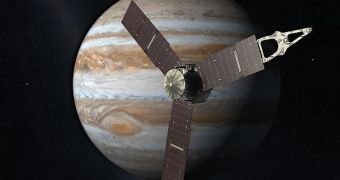A special kind of camera aboard the NASA Juno spacecraft was recently able to collect an impressive short clip of the Earth and the Moon hanging in the black of space, as they would appear to any alien visitor. The images used for this animation were collected during a Juno flyby on October 9, 2013.
The gravity assist maneuver was conducted in order to boost the speed of the probe by more than 7.3 kilometers per second, or 8,800 miles per hour. The flyby was successful in setting Juno on a trajectory that will allow it to enter orbit around Jupiter on July 4, 2016.
Juno features a suite of nine scientific instruments, which will enable it to study the largest planet in our solar system to an extent not possible before. NASA hopes to get as much scientific benefit from this mission as it does from the Cassini orbiter around Saturn.
The instruments on Juno are the Microwave radiometer (MWR), the Jovian Infrared Auroral Mapper (JIRAM), a Magnetometer (MAG), Gravity Science (GS), the Jovian Auroral Distribution Experiment (JADE), the Jovian Energetic Particle Detector Instrument (JEDI), the Radio and Plasma Wave Sensor (Waves), an Ultraviolet Imaging Spectrograph (UVS) and the JunoCam.
The camera the probe used to capture the Earth and the Moon is called the Advanced Stellar Compass (ASC), and it is a part of the MAG suite. The instrument was able to provide a unique low-resolution view of our planet and its natural satellite (see video below).
“If Captain Kirk of the USS Enterprise said, ‘Take us home, Scotty,’ this is what the crew would see. In the movie, you ride aboard Juno as it approaches Earth and then soars off into the blackness of space,” says the principal investigator of the Juno mission, Scott Bolton.
“No previous view of our world has ever captured the heavenly waltz of Earth and Moon,” adds the expert, who holds an appointment with the Southwest Research Institute (SwRI), in San Antonio, Texas.
ASC began collecting image of Earth and the Moon when the spacecraft was located around 966,000 kilometers (600,000 miles) away. “Everything we humans are and everything we do is represented in that view,” concludes the designer of the instrument, Danish Technical University in Copenhagen expert John Jørgensen.
Once around Jupiter, the spacecraft will conduct 33 science polar orbits around the gas giant, and take in-depth looks at its atmosphere, storms, magnetic field, auroras, and other features.

 14 DAY TRIAL //
14 DAY TRIAL //